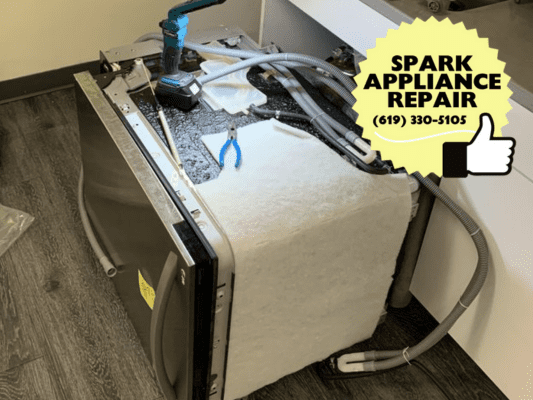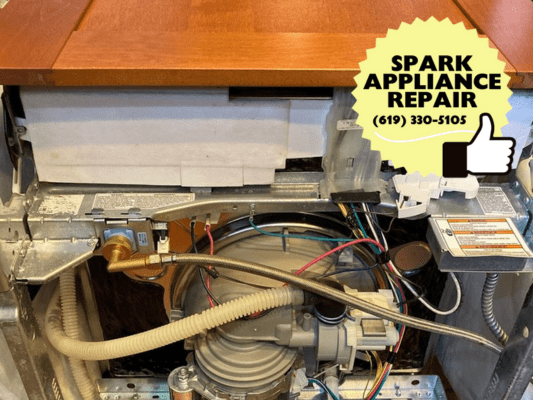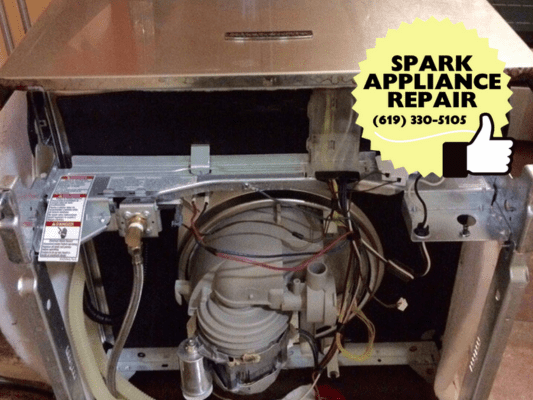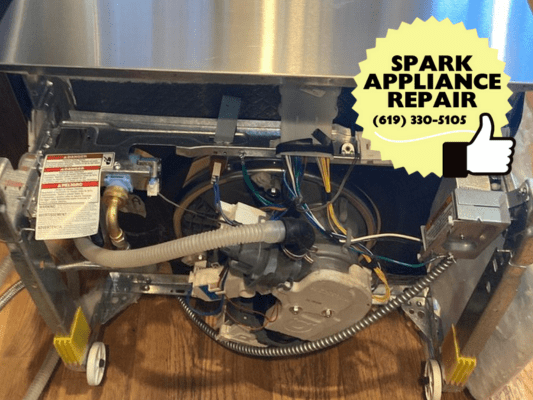
Top 10 Common Dishwasher Problems: Symptoms, Causes & Solutions
Dishwashers are invaluable time-saving appliances in kitchens across America. However, even reliable brands and models can experience common failures interrupting their cleaning capabilities. According to experts, most dishwasher breakdowns can be attributed to an underlying common problem with a straightforward fix. By understanding the causes and solutions for the most prevalent dishwasher malfunctions, homeowners can address issues promptly and cost-effectively. This guide will cover the main culprits behind the top common dishwasher problems and breakdowns along with DIY and professional resolutions to tackle each one.
Most Common Dishwasher Problems
Not cleaning dishes properly
If your dishwasher is not properly washing grease, food debris and residue off dishware, the issue likely lies with water circulation issues blocking the unit’s cleaning action. Clogged or worn spray arms prevent pressurized water from rolling dishes during wash cycles. Pumps or motors dispersing water pressure may have components in need of testing or replacement. Finally, improper water supply levels can trigger poor performance if valves are obstructed or water volume dropped too low due to utility issues.
To address dish cleaning problems:
-
Carefully remove spray arms and use a toothbrush to dislodge and clear built-up particles clogging passageways to restore full coverage water jets during cycles.
-
Diagnose pumps and motors with an appliance specialist to determine repairs needed for optimal water distribution.
-
Lastly, inspect supply valves under the unit eliminating kinks in hoses while confirming municipal water pressure meets unit requirements to distribute adequate volumes for cleaning action.
Leaking water
One of the most disruptive common dishwasher problems is steady water leakage on surrounding floors and cabinets. This issue typically arises from worn or warped door seals past their prime no longer containing leaks. Installation glitches like uneven gaps or tipping can also strain the machine allowing water to drip out around imperfect door alignments. Less frequently, cracks in interior basin linings from dropping heavy dishware or rust formation poke tiny holes for moisture to seep.
What you can do:
-
The most direct solution is to replace overly weathered door seals preventing further leaks around its perimeter.
-
Ensure the unit sits evenly with all feet making level contact on the floor. Tipping should never exceed an inch for stable function without leakage risks.
-
Lastly, minor basin lining cracks should be sealed with waterproof appliance epoxy while splits exceeding an inch will require assistance welding the stainless-steel tubing from a restoration service.
Resolving water leaks quickly prevents disrupting adjacent cabinetry along with more major repair costs if flooding damages property or mold sets in.
Unusual Noises
Strange sounds emanating from your unit like loud buzzing, grinding gears or high-pitched squealing indicate potential dishwasher problems in need of diagnosis. The most common causes of racket stem from an object like broken glass, utensils or dishes trapped mid-cycle interrupted water sprays necessary for cleaning action.
As internal mechanisms like circulation pumps and motors age and eventually wear down, normal operation whirs give way to conspicuous rattling signalling part fatigue. Lastly, tiny items blocking drain lines cause back up forcing water to reroute unnaturally loud while straining aligned components.
How to solve:
-
Begin troubleshooting by pressing pause and carefully inspecting items mid-cycle to remove anything obstructing normal route rotation.
-
Then engage drain mode ensuring no leftover debris gets flushed down to block drain lines creating unnecessary strain noises.
-
Have your pump motors tested next if disruptive whining or grinding sounds point to loss of smooth performance over years of use.
-
Aligning parts may also solve clanks if attachments came loose over time before full replacement becomes necessary.
Won't Fill With Water
If your dishwasher won’t start its cycle at all due to an inability to fill the interior basin, restricted water supply issues are likely the problem. Kinks or pinches in the external hook up hose cut off water flow completely. Internal fill valve flaps designed to release and stop water to maintain basin levels can fail over time not allowing any entrance water pressure. Electronics in control panels dictating water volume based on settings can also short circuit if units exceed age expectancy.
What are the solutions:
-
Examine hoses for tight bends and secure clamps to verify unobstructed pathways into the system.
-
Replace outdated or faulty fill valve flaps that will burn out after excessive use over many wash loads.
-
For control panel issues, verifying electrical connections can resolve loose wires but complete control board replacement may be necessary if complex wash program buttons or displays face full malfunction.
-
Restore smooth water feed lines before testing cycles to ensure the basics get addressed for functionality.
Won't Drain Water
Backed up dishwasher basins failing to drain leftover water after cycles often have drain lines suffering obstructions. Malfunctioning drain pumps designed to force spent water outward through disposal connections can burn out over years especially with heavy use. Drain hoses tucked under sinks can also get kinked losing drainage route direction. Lastly, gaps meant to prevent backflow between home plumbing and the dishwasher interior collecting debris alters proper functionality.
What you can do:
-
Begin by removing blockages whether it's broken glass near the drain, chunks of food trapped in concealed hoses under the unit or stuck film buildup in anti-backflow valves known as air gaps. Drainage regains normal flow preventing water pooling up instead of draining out.
-
From there, replace compromised drain pumps allowing unobstructed water propulsion.
-
Check hoses along bottoms and rear sides to release any tight bends that obstruct outgoing water lines.
-
Finally clear air gaps meant to keep sink grease and particles from your supposedly clean dishes after washes finish.
With all drain lines restored, water can fully empty basin interiors after each use.
Not Drying Dishes Properly
Dishes emerging from wash cycles still wet or streaked with moisture indicate evaporative drying issues. Low rinse agent dispenser fluid prevents water beading necessary for complete moisture evaporation. Venting meant to circulate humid air outward gets congested lowering drying efficacy over time. Homes with water softeners also face residue sticking without the final rinse aid application.
How you can fix it:
-
Prevention starts with prompt rinse aid refills per the owner’s manual instructions as bottles empty, typically monthly.
-
Beyond liquids, pulling out the dishwasher to inspect vent line filters clears any potential build up of gunk which commonly happens annually restoring airflow.
-
Water softener settings may also need adjustment so the final rinse disperses minerals needed for drying action instead of solely purified water.
Follow troubleshooting steps to uncover the root cause and restore fully sparkling dry dishware.



Key Takeaways: Preventing Breakdowns
Stay ahead of repairs by scheduling annual dishwasher maintenance checks even without noticeable symptoms arising. Signs of future malfunctions show up during routine maintenance like worn seals and early clogs before catastrophic events like motor failures or water damage incidents strike. Technicians also keep optimized detergent levels, ventilation line clears and part alignments for maximum cleaning performance year after year.
Conclusion
Catching common dishwasher problems early and understanding repair protocols keeps units safely and consistently removing messes from daily cooking. With some periodic upkeep precautions and DIY troubleshooting willingness, homeowners can clear up many basic breakdown issues themselves without complicated repairs. However, relying on a trusted appliance service technician always ensures proper protocols get followed.
Frequently Asked Questions
Worn down motors is a common problem causing unusual grinding noises from dishwashers after years of use. Testing and replacing exhausted motors is the solution to this common problem.
Dishwashers failing to fully drain due to clogged drain lines is a common problem signaled by standing pools of water leftover after cycles finish. Clearing blockages addresses this common issue.
Tripped electrical breakers abruptly cutting power during operation is a common problem from overloading circuits. Resetting breakers restores normal function once this common issue gets addressed.
Defective water inlet valves preventing water supply fails commonly after 5-7 years of use leading to no fill situations. Identifying bad valves early is key before interior components get damaged from a common problem.
Partially obstructed water jets and spray arms is a common problem reducing access all over interiors. Systematically cleaning all wash arms resolves this common cause of uneven cleaning results.






